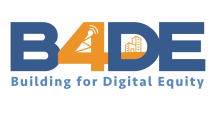
Fast, affordable Internet access for all.

If you missed our most recent Building for Digital Equity Livestream – Life After ACP – the virtual event can still be seen in its entirety (below).
The entire event focused on the imminent end of the Affordable Connectivity Program (ACP) and featured a lineup of speakers who shared on-the-ground perspectives and approaches being adopted at the community level to deal with the broadband affordability crisis in the absence of the popular federal program that has served 23 million Americans since its inception two years ago.
As a bonus, we are sharing links to the speakers slide decks below.
The first of two lightning round speakers, Margaret Käufer – President of The STEM Alliance – gave an overview on the short and long-term work her organization is doing in upstate New York in the face of ACP’s demise. You can find her slide deck here.
The second lightning round presenter Jason Inofuentes – Program Manager for the Broadband Accessibility and Affordability Office in Albemarle County, VA – unveiled an ACP supplement program his office is pursuing and how they see things moving forward. Those slides are here.
The first of the main presenters – Monica Gonzales, Digital Equity Supervisor for Methodist Healthcare Ministries in Texas – gave an overview of what her faith-based nonprofit healthcare organization is doing to address affordable connectivity across the 74 county South Texas region served by MHM. Gonzales’ slides are here.
The IT Director for the City of Pharr, TX, Jose Pena, followed Gonzalez with a presentation on how his city embarked on a more structural approach to bridging the digital divide in what had previously been considered one of the worst connected cities in the U.S. He covered how PharrConnect is able to provide gig speed fiber service to low-income student households at no cost to the family. His slides can be found here.
Finally, the keynote speaker Rebecca Kauma, Director of Digital Equity for the County of Los Angeles, spoke to what LA County was doing to create bottom-up structural solutions to address the digital divide in one of the largest metro areas in the nation. Her slides are here.
Below you can watch the entire #B4DE livestream:
